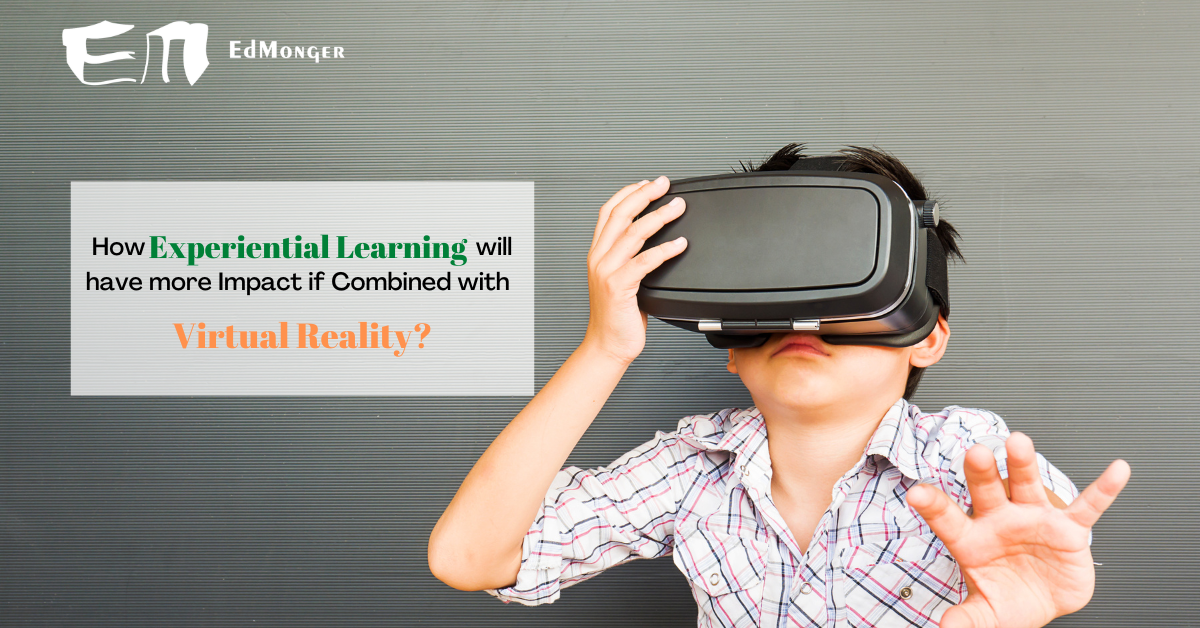The most effective delivery method for “experiential learning” is through virtual reality applications. This educational philosophy is centred on the notion that we learn and remember things better when we experience them for ourselves rather than when we are taught what they mean.
To enhance the students’ experiment-based learning experiences, virtual reality has been deeply explored to its strength. Virtual reality enables the students to virtually engage and learn those subjects using experiments (or we can say practically) which they find very challenging. Gone are the days when students simply read books to gain knowledge or clear their doubts. Virtual Learning aids the students in learning through experiments in conceptual subjects like science and maths.
Technology is undoubtedly the secret to profound conceptual knowledge, and with the advent of virtual reality in education, students will get a whole new user experience with enjoyable Learning.
Experiential Learning using Virtual Reality Applications: The Strength Of Edtech
Experience-based Learning now uses both virtual and augmented reality, enhancing students’ grasping power. When it comes to using virtual reality applications for experiential learning in educational institutions, it is utilized to observe situations, engage many of the student’s senses, and provide them with a unique hands-on learning opportunity.
Students’ learning experiences become more personalized and realistic due to their ability to engage virtually with the topics taught to them.
They are free to act on their initiative, putting ideas into practice and thinking about them. After every VR experience in the classroom, real-time interaction and feedback will aid students in making the best use of their newly acquired information.
Combining Experiential Learning With Virtual Reality: The Benefits
Enhanced Creativity
Students are likely to be more creative in visually engaging classrooms. There would be more to think about, and they may come up with creative answers.

Let’s take an example of a science class where students learn about the human circulatory system; here, virtual reality applications help students experience every part of the human body. This will increase engagement and give students much ground to show their creative ideas.
They can use a console to view inside the body to understand the heart’s function and the significance of red blood cells in the regular circulation of blood to various organs.
These “look-see-do” learning approaches enable students to use their imaginations by allowing them to explore, recognize, and play with the information in their thinking process.
Adaptive Approach
Students may communicate with one another freely in VR, which encourages interpersonal interactions. These things make them extroverts and adaptive to every situation.
Many students avoid experiential Learning because they are anxious or afraid of being judged. Before implementing it in real life, they may practice their abilities and build confidence in a secure environment.
As a result, the student will have more self-assurance, communicate openly with his management and team and be better able to deal with obstacles in his work life, all of which will contribute to his overall progress.
Adapting the teaching process
In contrast to traditional teaching techniques, which only enable students to view a class once and take notes to remember later, VR Classrooms give students limitless access to practice lessons and the prompt feedback required for efficient instruction.
Students will gain significantly from this. The effectiveness of visualizing over reading information has also been demonstrated repeatedly. Virtual reality (VR) provides brand-new visualization formats and techniques that effectively represent the needed ideas.
Virtual Reality And Experiential Learning: Impact On Major Subject
In Science
VR combined with experiential Learning makes understanding a subject simpler. Using VR Labs for scientific experiments is undoubtedly one of the most effective ways to teach it to students. They cannot be seen with the eyes, thus, understanding the reasoning behind them needs some degree of imagination, provided by VR and experiential Learning.
Students can observe what is happening throughout the experiments, including the double and triple bonds between atoms, Newton’s Laws and their applications, and anything else, thanks to virtual reality, which fills this gap.
In Engineering
Every institution needs equipment worth thousands of dollars to understand deep engineering concepts. But VR labs are comparatively cost-effective. Educational institutions can set up labs with VR technology and helps the students to sharpen their skills with experiential Learning.
By wearing the necessary headgear, students may learn about many engineering areas, such as mechanical and electrical engineering. They can quickly comprehend an induction motor’s operation or examine how a computer shuts down on its own when it gets too hot. Even better, they may put on a virtual reality headset and enter a thermal power plant to observe it in action.
In Architectural Design
Architects must develop high-quality designs that enable clients to comprehend concepts effectively if they want to design structures that please clients. The design communication must be limitless.
Three-dimensional digital modelling is useful in this situation, and architecture students can get a head start by using it in college during their early years.
In Medical Field
Universities may save a lot of money by using VR labs in various medical disciplines, including human anatomy, physiology, biochemistry, dissection, etc.
Compared to viewing a film or reading about it, they may simply explore in 3D how different organs in our body function.
They used virtual reality to simulate a patient with one of these conditions to teach medical students how to treat patients with age-related disorders.
What Do I Think?
Virtual reality applications in experiential Learning still have untapped potential. Numerous businesses provide cross-platforming, allowing students to use virtual reality (VR) on devices other than their smartphones, such as computers and iPads.
As a result, Learning will be significantly gamified. Indulging in the newest trend is the best approach for educational institutions to attain remote education, which is currently a must. Experiential learning methods will be improved more than ever by virtual reality, which is here to stay. If you are a school owner or a parent, you must think about giving experiential Learning to your students and kids by leveraging virtual reality. Because the future will be more competitive, we must start from today itself.




